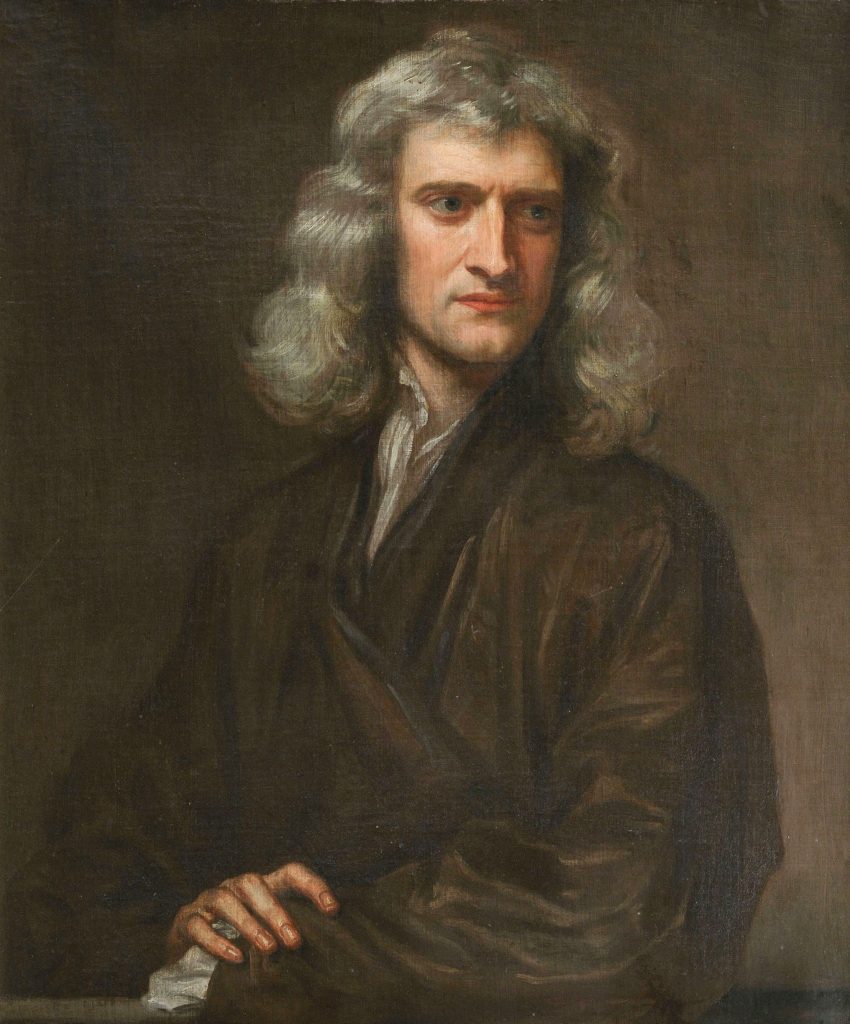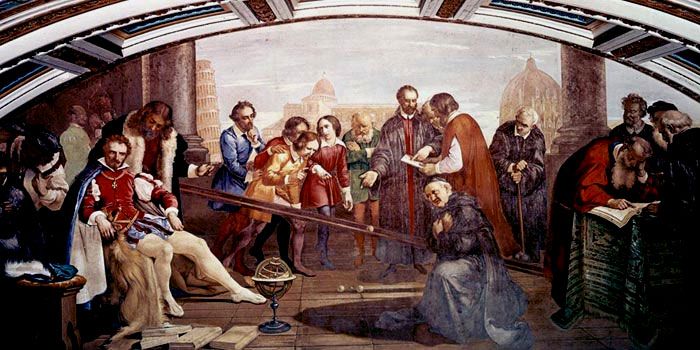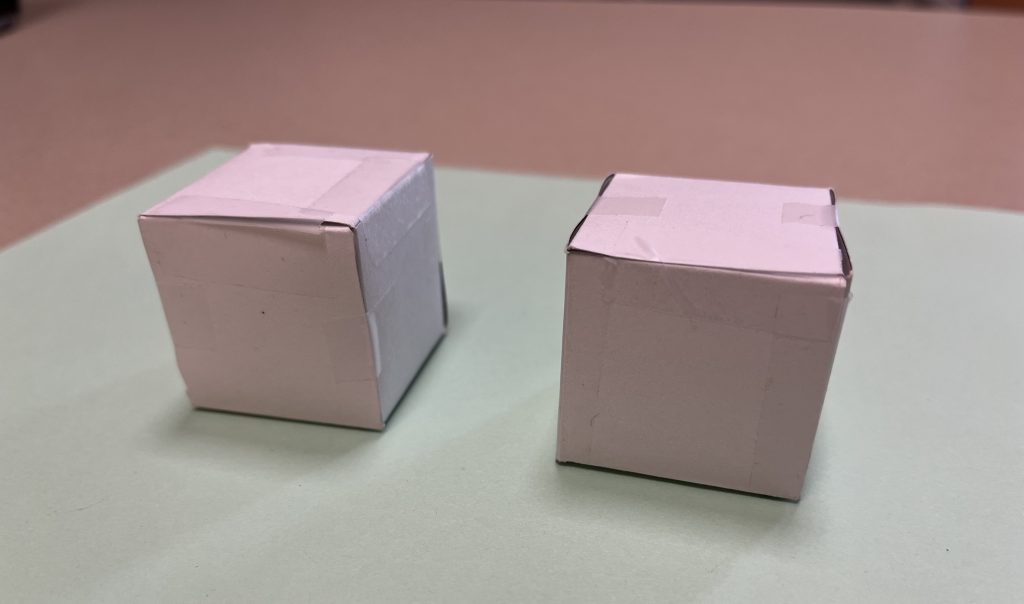23 Newton’s Laws (Graded Reading)
Janice Hester

Isaac Newton was an English mathematician and natural philosopher (astronomer, physicist, and alchemist) that lived in the late 1600's and early 1700's (after Galileo, Kepler, and Brahe). His iconic work, the Principia Mathematica was published in 1687. In this work, he proposed his laws of motion and gravity and used them to derive Kepler's laws of planetary motion. That is, he showed that if his ideas about motion were correct, then Kepler's observations about planetary motions were the natural result of the Sun's gravity pulling on the moving planets.
Newton's First Law of Motion
Newton summarized his ideas about motion -- which built upon work by Galileo, Descartes, and others -- into three "laws". These three laws describe how forces acting between objects cause changes in those objects' motions.
Newton's first law states that in the absence of an external force, a moving object will keep moving, in a straight line, at a constant speed. This first law is a formal statement of Galileo's observation that, in the absence of external forces, an object will continue to move. More specifically, it will continue to move at a constant velocity (constant speed and direction).

Another of Galileo's thought experiments demonstrates this. Imaging a ball rolling along a smooth ramp. If the ramp is tilted down (the ball rolls downhill), the ball will speed up. If the ramp is tiled upward (the ball rolls uphill), the ball will slow down. But what lies exactly in between speeding up and slowing down? What will happen if the ball rolls along a smooth level ramp? If the ball neither speeds up nor slows down, then it must continue at a constant speed.
Newton's Second Law of Motion
Newton's second law is summarized as the famous equation Force equals mass times acceleration ([latex]F=ma[/latex]). The core idea captured by Newton's second law is that changes in motion -- called accelerations -- are caused by forces. Accelerations include anything other than moving in a straight line at a constant speed. Speeding up, slowing down, and changing direction are all accelerations. And, if an object is accelerating, there must be a force acting on it (forces causes accelerations, not vice versa). As the planets orbit the Sun, they experience all of these accelerations - speeding up then slowing down as they approach the Sun and then move away from it and turning to follow their elliptical orbits. (Notice that while the everyday definition of accelerate is to speed up; to a physicist or astronomer, slowing down is also an acceleration.)
Force & Acceleration

Unlike motion, you can feel accelerations (with one very interesting exception). Imagine you are passenger on a long road trip. What motions of the car can you feel? When the car speeds up (an acceleration), you feel pushed back into you seat. When the driver hits the breaks and the car slows down (also an acceleration), you feel thrown forward. And when the car drives around a bend (another acceleration), you feel a push to the outside of the turn. When the car is driving down a smooth, level section of road at a constant speed (cruise control activated), you don't feel the car's motion.
An object's acceleration is in the same direction as the net (or total) force acting on it. A car starts moving and speeds up because traction between the tires and the road is pushing it forward. Similarly, a car slows down when there is a net force opposing its motion, acting backward on the car. (When you hit the breaks, the wheels spin slower and the traction between tires and road now pushes backward on the car.) To generalize, pushing an object the direction that it is moving causes it to speed up and a force opposing the motion (opposite direction) causes the object to slow down.
The direction of the force that causes an object to speed up or slow down is fairly intuitive. Turning is less intuitive, but we can start by stating that an object turns right when a force pushes it to the right and left when a force pushes it to the left. Now imagine driving a car around a sharp right turn. A force pushing the car (and you) to the right is required in order to turn the car -- otherwise it would continue moving in a straight line. Viewed from above, this push is towards the center of the turn. You, however, feel thrown to the left, towards the outside of the turn. This perception of being thrown outward causes the common misconception that there is a force pointing outwards, away from the center of the turn, but there isn't. The force that causes the turn is inward.
This feeling of being pushed in a direction opposite your acceleration actually happens for all accelerations (again with one exception). When a car that you are riding in suddenly breaks, the acceleration opposes the motion, but you feel thrown forward. Similarly, when a car suddenly speeds up, accelerating forward, you feel thrown backward. The same for a turn. When a car accelerates to the right (turns right) you feel pushed to the left, and vice versa.
Again, forces causes accelerations and accelerations don't happen without a sufficient force. Cars are a good example of this as well. Try to stop too fast or turn to hard and you will loose traction between the tires and the road and start to slide. There is a maximum force on the car that traction can provide and thus a maximum acceleration possible. Try to accelerate more than this and you will fail.
Inertial Mass
An object will accelerate in the direction of the net (total) force acting on it, but how much will it accelerate? The answer to this question depends on the object's inertial mass.

Imagine that you are looking at two small, apparently-identical boxes. You are told that one of the two boxes is more massive than the other, and are asked to determine which box is more massive -- without picking them up. When real students are given real identical boxes, they quickly solve this problem by pushing or tapping on the two boxes. They can easily feel which box seems to have more "resistance" to the push or tap. This is the more massive box. When students are then allowed to pick up the boxes, they are not surprised that the more massive box is also heavier.
The property of the boxes that the students measure when they push on them is their inertial mass. The more massive an object is, the more it resists changes to its motion. That is, more massive objects are harder to accelerate. Keep in mind that no matter how massive an object is, it still requires zero force to keep it moving at a constant velocity. More massive objects are in fact harder to slow down (imagine the force that would be needed to stop the Earth in its orbit).
Newtons Third Law of Motion
Consider the feeling of your feet on the floor. As your feet push into the floor, the floor pushes up on your feet. Similarly, if you slap your desk (not too hard) you will feel a force on your hand. This symmetry is Newton's third law.
Newton's third law is often summarized as every action has an equal and opposite reaction. If we stop there, it's easy to misunderstand this final law. The key point is that forces happen between pairs of objects. When your feet push down on the floor -- the action -- the floor pushes up on your feet -- the reaction. The pair of objects is your feet and the floor; these two objects push on each other.
Forces always come in action-reaction or third-law pairs between two objects. For example, when a cup sits on a table, there is a force pair between the cup and the table. The table pushes up on the cup, and the cup pushes down on the table. If you push on the cup, sliding it across the table there is a force pair between you and the cup. As you push the cup, you'll feel it pushing back on you. Gravity also comes in force pairs. As the Earth pulls down on you, you are pulling up on the Earth. As the Sun pulls the Earth inwards towards itself, the Earth pulls back on the Sun.
Each of these pairs of forces are equal in size and opposite in direction (equal and opposite). The equal in size might come as a surprise, particularly for gravity. Your weight is a gravitational force pulling you towards the center of the Earth, holding you on its surface. As the Earth pulls down on you, you pull up on the Earth, with a force that is just as strong as the pull of the Earth on you. Similarly, the Earth pulls on the Sun with a force that is just as large as the pull of the Sun on the Earth.
This might seem paradoxical, after all, the Earth orbits the Sun, not vice versa. To solve this paradox, consider Newton's second law. Yes, the Sun and Earth exert equal forces on each other, but the Sun is about 300,000 times more massive than the Earth. The more massive Sun accelerates much, much less than the Earth. But, the Sun does wiggle a little as the planets pull on it. (This stellar wiggle is one way to detect planets orbiting around other stars.) Similarly, you are much less massive than the Earth. So when you jump up, you fall back to Earth, not vice versa.
